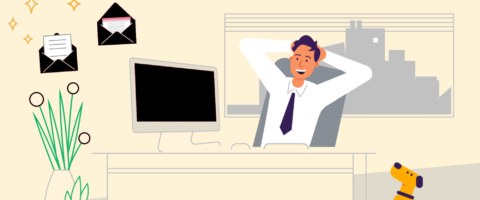
By Tim Holt 6 min read

You're writing a B2B email, so you already know that you need to be professional and approachable, but what does that mean? Well, it means that the tone of your copy should be clear, concise, and compelling. It's not enough just to pass along information—you want your reader to feel compelled to read on!
In our experience with B2B marketing, we've learned how important it is for emails to stand out from all the other messages in their inboxes. With so many emails being sent every day (and with such high expectations), it can be hard for marketers even within the same organization to consistently write email copy that gets noticed. However, if you keep these tips in mind and follow them closely when composing your next campaign:
Use your subject line to stand out.
Make your subject line stand out by using language that makes you different.
Avoid words that make what you're offering seem urgent or important—they're overused and will only get lost in the inbox shuffle. Instead, opt for something unique, like "Check out how we're revolutionising customer service."
Also steer clear of using standard abbreviations like "fwd" or "reply," which could trigger spam filters. Instead, use a more descriptive subject line like: “We’re looking for someone to join our team in London!”
Include the recipient's name in the email body if it's relevant — e.g., "Hi Jim" or "Dear Kate." This personalisation will help you stand out from other emails from similar companies and will make others more likely to read your message (and respond).
Get personal with the greeting.
One of the first things you can do to establish a personal connection with your readers is by addressing them by name. The best way to do this is to use their name if possible, but you can also use their title or company name. You can also get creative and find out what industry they're in, then incorporate that into your greeting (for example: "Hi [name], thanks for being a customer!").
Finally, don't forget about location! If there's any chance you know where someone works, it's worth mentioning it in your greeting as well. This will help build trust and show that you care about them as individuals rather than just another faceless contact on an email list.
Keep it simple, but not too simple.
If you're going to write a B2B email, keep it simple.
It's easy to get carried away with the grandeur of your messages and try too hard to impress your clients with big words or complex ideas. But remember: these are business people, not scholars or intellectuals. They want things that are quick and easy to read—not something they have to spend an hour trying to understand just so they can save money on their next purchase!
In general, try following these guidelines when writing emails. Keep it short and sweet (with good grammar). Your readers don't want a lot of extra fluff; they want information conveyed in simple language with clear instructions on how they can take advantage of what you're offering. So leave out unnecessary details, use short sentences and paragraphs, write in a conversational tone (rather than formal) and avoid jargon when possible.
Include great copy for the body.
The body is the most important part of your email. This is where you should include great copy for your reader, including a strong call to action and closing statement.
The first thing you should do is make it clear what the reader should do next. You can do that by using a strong call to action (CTA) in your email: “Click here now!” or “Download this report today!” These CTAs are effective because they tell readers what they need to do next (and nothing else). They also help motivate readers by providing value in exchange for their time spent reading your message.
You may also want to consider including a second CTA at the bottom of your message that asks subscribers if they would like more information about what you're offering. This gives them an easy way out if they don't want anything further from you, but it also allows them another chance at receiving valuable information from you later on down the line if necessary—you won't lose any potential customers just because there isn't an explicit opt-in option available now!
Use short sentences and paragraphs.
In addition to being a great way to get your point across, short sentences and paragraphs are also some of the most effective ways to keep your readers reading.
They’re easier to read, they engage readers more quickly, and they make it easier for them to understand what you’re saying. In fact, the Flesch-Kincaid Readability Test—a tool used by many companies to determine how easy their content is for people with different levels of education—ranks long sentences higher than short ones in terms of readability (though there are other factors as well).
Lead with benefits rather than features.
As you begin to craft your B2B email copy, remember that benefits are the most important part of your content. What does this mean?
Benefits are what the product does for you—what it can do for your business, how it will help you achieve a goal. Features are just facts about the product: what it looks like, how much it costs, and so on. They're boring! Your readers probably know these things already—they want to know what they'll get out of using or buying from you specifically.
Be conversational and real.
Be conversational and real. Just like people, brands are often perceived as being more human when they're direct, honest and friendly. You might be wondering: Is it okay for a brand to use contractions? Absolutely! When you talk about your customers' problems, frustrations and aspirations in the same way you would with a friend, you'll come across as authentic—and that's exactly what your reader wants from you.
As for the tone of your email copy...
Have a strong call to action and close.
The call to action is the final step in your email. It’s what gets the reader to take action, whether that means clicking on a link or calling you to learn more.
The goal of a good call to action is to encourage the reader—whether they're already familiar with you and your product or they are just learning about you—to take immediate action. In other words, give them a reason why they should complete their purchase now instead of later.
This can be done by highlighting key benefits like an offer of free shipping or money back guarantee if you aren't satisfied with the quality of our product after 30 days.
You should also include an incentive that helps motivate buyers who may not be ready yet but will soon become interested in buying from you (e.g., “Don't miss out! Hurry up before it's too late!”).
B2B email marketing doesn't have to be boring or impersonal; you can write an engaging email that motivates your reader to take action!
It's true that B2B emails are more formal and brief than their consumer counterparts. But that doesn't mean they can't be both professional and fun. In fact, the very nature of a business audience means that you have the opportunity to be creative in ways most other segments don't.
Conclusion
We’ve covered a lot of ground here, and hopefully you feel more confident about writing B2B emails. Remember that email marketing is a conversation between you and your reader, so make it personal! Use your subject line to stand out, get personal with the greeting, keep it simple but not too simple (but make sure there’s plenty of white space), include great copy for the body—and remember: lead with benefits rather than features. Finally, be conversational and real while having a strong call to action at the end that closes with a flourish.
Related blogs and ideas
Explore more ideas
Let us open your mind to new possibilities
Our stories and ideas direct to your inbox





